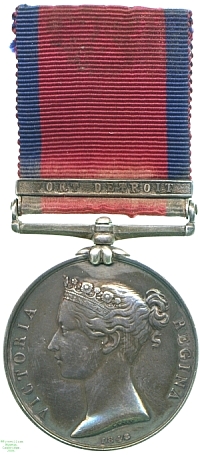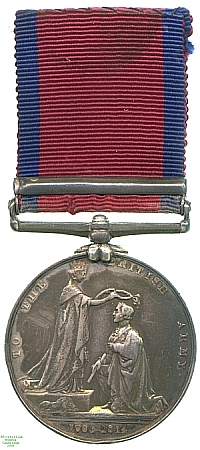
Obverse, a bust of Queen Victoria facing left

Reverse, Queen Victoria on dais placing a wreath on the head of the kneeling Duke of Wellington

Obverse, a bust of Queen Victoria facing left |

Reverse, Queen Victoria on dais placing a wreath on the head of the kneeling Duke of Wellington |
It had been unusual, before the reign of Queen Victoria, for medals to be issued recognising service in campaigns (except perhaps those organised by the East India Company). This left, for example, veterans of the Napoleonic Wars with nothing to display for their service, and therefore three medals were instituted in 1847-1848 for campaigns of the previous fifty years, in the East India Company's forces, in the Royal Navy or in the Army, the last of which was the Military General Service Medal, instituted in 1847 and first struck in 1848.
The intentions of the medal committee are hard to divine, as the medal was struck carrying the dates `1793-1814' in the reverse, but the earliest campaign considered was that in Egypt from 1798 to 1801. Earlier battles may have been deleted from consideration due to the shortage of surviving veterans of engagements of the previous century. This was one of the paradoxes shared by all three of the General Service Medals, another being that the monarch whose portrait they bore, Queen Victoria, was not him for whom the recipients had fought.
Although most of the campaigns for which the MGSM was awarded were fought in the Peninsular War, leading to the piece being frequently known as the Peninsular Medal, it was also awarded for conflicts far further afield. These included the War of 1812, sometimes known as the Anglo-American War, on the other side of the Atlantic.
Originating in British arrests of United States ships in the cause of the blockade of France necessitated by the Napoleonic Wars, and various resentments left over from the American War of Independence, the War included two United States invasions of Canada. The first, in 1812, ended ignominiously; the US force turned back toward Detroit after two defeats at the hands of Canadian militia, and then its leader Brigadier General William Hull surrendered there after he was allowed to discover a fictional British plan to capture the city using native American troops.
The bar for the capture of Detroit bears the name of the old Fort Detroit, even though this had been demolished after a fire in 1805. The medal which displays this bar in the Watson Collection was awarded to Captain John Bostwick of the Norfolk Regiment of the Canadian Militia. Lester Watson purchased the medal in 1927.